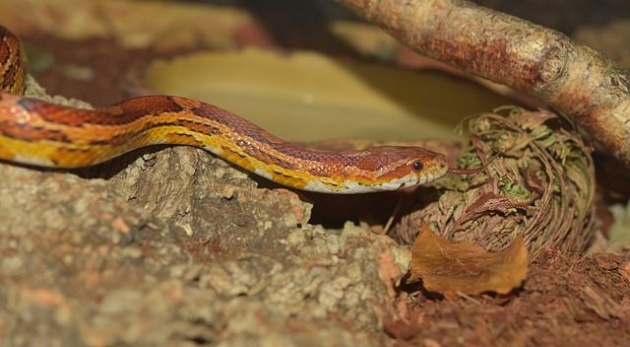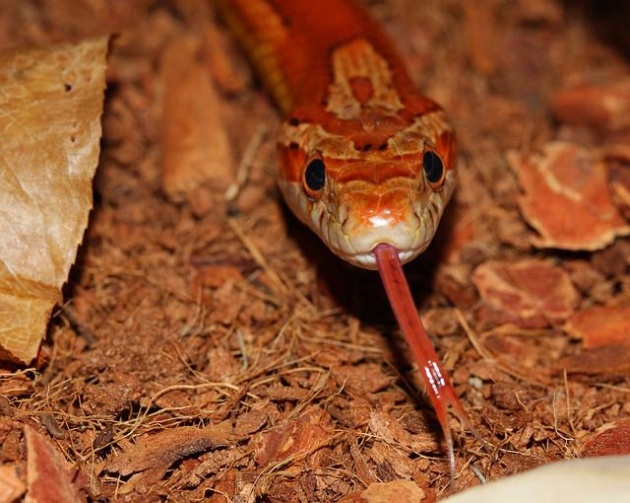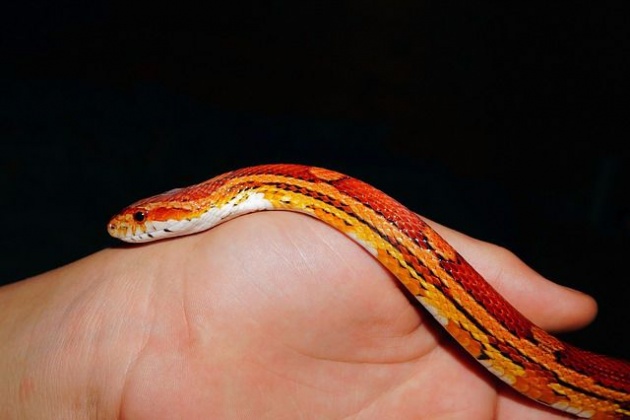Most snakes are known by most individuals as venomous and highly dangerous reptile creatures that bites. But, this isn't the case for the "Corn Snake". It's because this kind of snake are considered by researchers as "non-venomous". Thus, they can be even kept as pets.
When it comes into their diet, corn snakes do not usually eat every day. They actually feed themselves only every few days. The young can feed on small creatures such as lizards and tree frogs. As for the adults, they can feed on larger creatures such as mice, rats, birds, rodents and bats.
Corn snakes are constrictors. When hunting down a prey, the snake will first need to launch an aggressive bite into its target then followed by wrapping its body (with one or two coils) squeezing its victim tightly until it suffocates to its death. And just like all other snakes, it will swallow its food entirely by starting from the head of its prey. However, some researchers claimed where they happen to observed some corn snakes swallowing their prey alive.
If it happens that you haven't seen what a corn snake looks-like, refer to the images below:
 Corn Snake Habitat
Corn Snake Habitat
Corn snakes can be found in several different countries but in the United States they inhabit the regions of the Eastern United States, Southern New Jersey, South Florida, West Louisiana and some parts of Kentucky. But based from the researchers findings, the regions of Florida and Southeastern US has the highest population of corn snakes.
 The common environment where corn snakes can be encountered are in wooded groves, rocky hillsides, meadowlands, woodlots, barns and abandoned buildings. They also possess a good climbing skill which allows them to search for prey on tall trees. But surprisingly, they are very secretive creatures. It's because they love to spend most of their time underground hunting rodents.
The common environment where corn snakes can be encountered are in wooded groves, rocky hillsides, meadowlands, woodlots, barns and abandoned buildings. They also possess a good climbing skill which allows them to search for prey on tall trees. But surprisingly, they are very secretive creatures. It's because they love to spend most of their time underground hunting rodents.
Corn Snake Life Span and Reproduction
According to some researchers, the life span of a corn snake can reach up to 23 years in captivity but only 5 to 8 years to those that lives in the wild.
Regarding about their reproduction, the perfect breeding seasons for these reptiles starts from the month of March to May. Interestingly, corn snakes are "oviparous". This means that they lay eggs with little or "no" embryonic development within the mother.
There are commonly around 10 to 30 eggs laid on places that provides sufficient heat and humidity that can help in the incubation process of the eggs. Some of these places includes rotting stumps and piles of decaying vegetations. Unfortunately, the parent snakes do not care for their eggs.
Right after the eggs were laid, it will take between 60 to 65 days period for them to get hatch. Throughout this period, it is very important that the temperature of the nest will be maintained at about 82 Degrees Fahrenheit.
Once the eggs hatches, the baby snakes that comes out from their shells measures between 10 to 15 inches (or 25 to 39 cm) in length. And, they will reach their full maturity within 18 to 36 months.
Some Interesting Facts About Corn Snakes
1. Despite the fact that corn snakes are not venomous, the majority of individuals kills them because they have huge similarities to the copperhead - a dangerous and poisonous snake.
2. Farmers appreciates the presence of corn snakes in their agricultural farm because they keep the number of rodents under control. As benefits, they actually prevent spreading of diseases and crop damages contributed by large populations of rodents.
3. During the cold seasons, corn snakes will undergo hibernation.
 Moreover, corn snakes is not yet listed as an endangered species but several concerned group of organizations have taken actions. This is due to the reason that they are now facing habitat loss and destruction. And as already mentioned above, some of them are being accidentally killed and being sold as popular pets. If this goes on, corn snakes will no doubt be included on the list of endangered species.
Moreover, corn snakes is not yet listed as an endangered species but several concerned group of organizations have taken actions. This is due to the reason that they are now facing habitat loss and destruction. And as already mentioned above, some of them are being accidentally killed and being sold as popular pets. If this goes on, corn snakes will no doubt be included on the list of endangered species.



